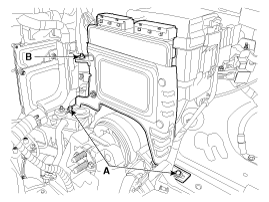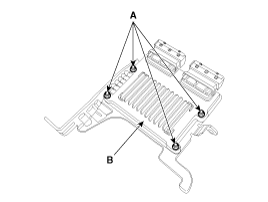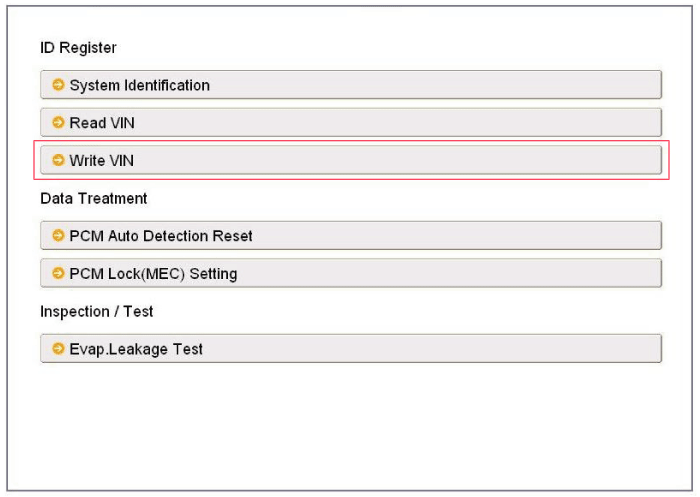Kia Cadenza: Engine Control System / Engine Control Module (ECM) Repair procedures
Kia Cadenza YG 2016-2025 Service Manual / Engine Control / Fuel System / Engine Control System / Engine Control Module (ECM) Repair procedures
| Removal |
When replacing the ECM, the vehicle equipped with the immobilizer must be performed procedure as below.
[In the case of installing used ECM]
[In the case of installing new ECM]
Perform "Key teaching" procedure with GDS.
(Refer to Body Electrical System - "Immobilizer System")
|
When replacing the ECM, the vehicle equipped with the smart key system (Button start) must be performed procedure as below.
[In the case of installing used ECM]
[In the case of installing new ECM]
Insert the key (or press the start button) and turn it to the
IGN ON and OFF position. Then the ECM learns the smart key information
automatically.
|
| 1. |
Turn ignition switch OFF and disconnect the negative (-) battery cable. |
| 2. |
Remove the cover. |
| 3. |
Disconnect the ECM connector (A).
|
| 4. |
Remove the air cleaner assembly.
(Refer to Engine Mechanical System - "Air cleaner" ) |
| 5. |
Remove the battery tray.
(Refer to Engine Electrical System - "Battery") |
| 6. |
Remove the ECM bracket installation bolts (A) and nut (B).
|
| 7. |
After removing the installation nuts (A), remove the ECM (B) from the bracket.
|
| Installation |
When replacing the ECM, the vehicle equipped with the immobilizer must be performed procedure as below.
[In the case of installing used ECM]
[In the case of installing new ECM]
Perform "Key teaching" procedure with GDS.
(Refer to Body Electrical System - "Immobilizer System")
|
When replacing the ECM, the vehicle equipped with the smart key system (Button start) must be performed procedure as below.
[In the case of installing used ECM]
[In the case of installing new ECM]
Insert the key (or press the start button) and turn it to the
IGN ON and OFF position. Then the ECM learns the smart key information
automatically.
|
| 1. |
Install in the reverse order of removal.
|
| ECM Problem Inspection Procedure |
| 1. |
TEST ECM GROUND CIRCUIT: Measure resistance between ECM and
chassis ground using the backside of ECM harness connector as ECM side
check point. If the problem is found, repair it.
|
| 2. |
TEST ECM CONNECTOR: Disconnect the ECM connector and visually
check the ground terminals on ECM side and harness side for bent pins
or poor contact pressure. If the problem is found, repair it. |
| 3. |
If problem is not found in Step 1 and 2, the ECM could be
faulty. If so, replace the ECM with a new one, and then check the
vehicle again. If the vehicle operates normally then the problem was
likely with the ECM. |
| 4. |
RE-TEST THE ORIGINAL ECM: Install the original ECM (may be
broken) into a known-good vehicle and check the vehicle. If the problem
occurs again, replace the original ECM with a new one. If problem does
not occur, this is intermittent problem.
(Refer to “Intermittent Problem Inspection Procedure” in Basic Inspection Procedure)
|
VIN Programming Procedure
VIN (Vehicle Identification Number) is a number that has the
vehicle''s information (Maker, Vehicle Type, Vehicle Line/Series, Body
Type, Engine Type, Transmission Type, Model Year, Plant Location and so
forth. For more information, please refer to the group "GI" in this
SERVICE MANUAL). When replacing an ECM, the VIN must be programmed in
the ECM. If there is no VIN in ECM memory, the fault code (DTC P0630) is
set.
The programmed VIN cannot be changed. When writing the VIN, confirm the VIN carefully |
| 1. |
Select "VIN Writing" function in "Vehicle S/W Management". |
| 2. |
Select "Write VIN" in "ID Register".
|
| 3. |
Input the VIN.
|
| 4. |
Turn the ignition switch OFF, then back ON. |
 Engine Control Module (ECM) Schematic Diagrams
Engine Control Module (ECM) Schematic Diagrams
ECM Terminal And Input/Output signal
ECM Terminal Function
Connector [E600-A]
Pin No.DescriptionConnected to1- 2- 3- 4Immobilizer Lamp control outputImmobilizer Lamp [Without Button E ...
 Injector Drive Box (IDB) Schematic Diagrams
Injector Drive Box (IDB) Schematic Diagrams
IDB terminal and Inoutput
IDB terminal function
Connector [C602]
Pin No.DescriptionConnected to1- 2- 3- 4- 5- 6- 7- 8- 9- 10- 11- 12- 13- 14- 15- 16Injector (Cyl ...
Other information:
Kia Cadenza YG 2016-2025 Owners Manual: Door locks
Operating door locks from outside the vehicle With the door lock button To unlock a door, push the door lock button (1) to the “Unlock” position. The red mark on the button will be visible. To lock a door, push the door lock button (1) to the “Lock” position. If the ...
Kia Cadenza YG 2016-2025 Service Manual: Alternator Schematic Diagrams
Circuit Diagram • COM signal - When controlling the voltage generated, the ECM sends the target voltage data to the alternator via a PWM signal.(High voltage: 4V or higher, low voltage: 2V or lower) • FR signal - The transistor activation ...
Copyright © www.kcadenzavg.com 2017-2025








